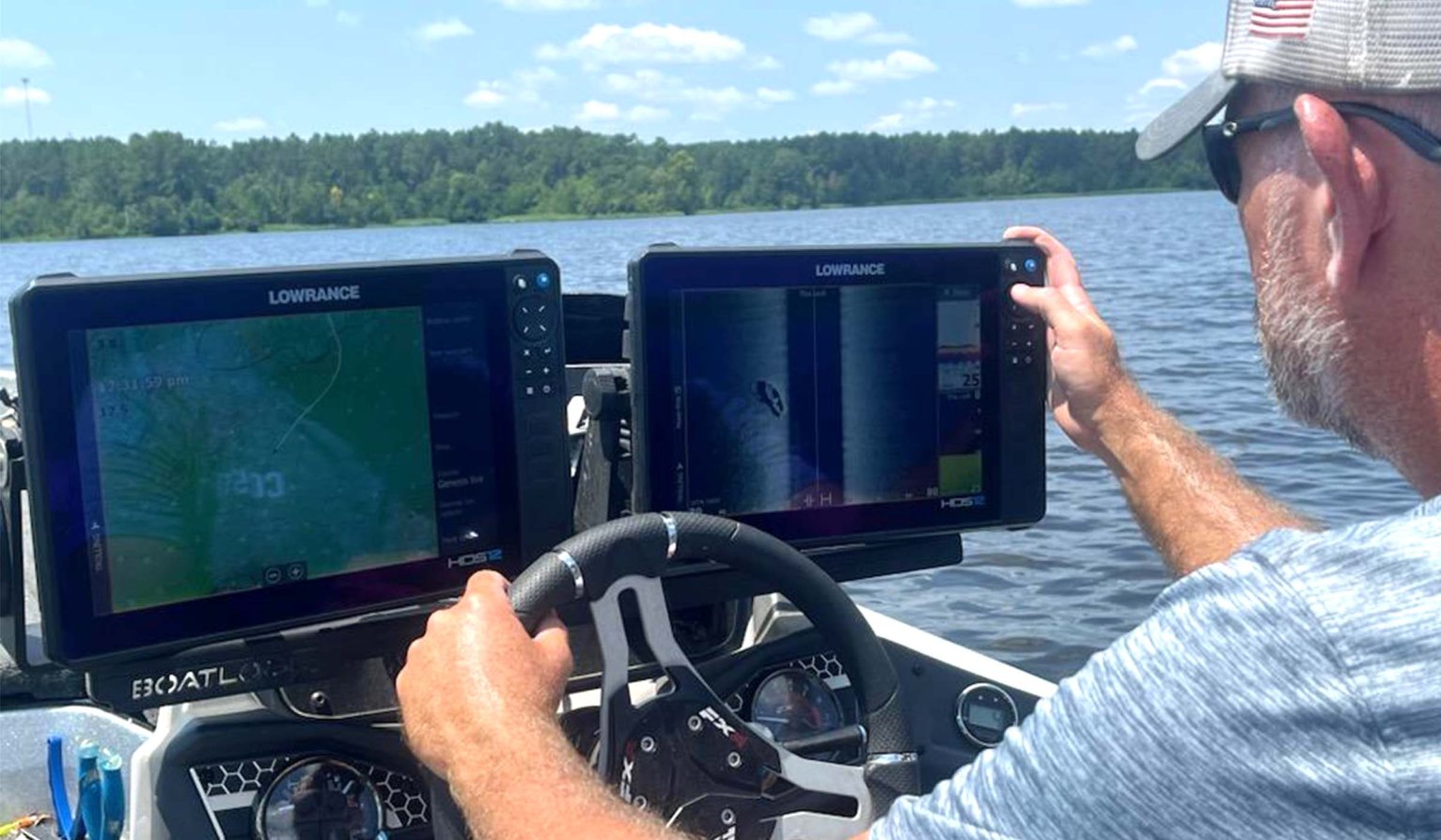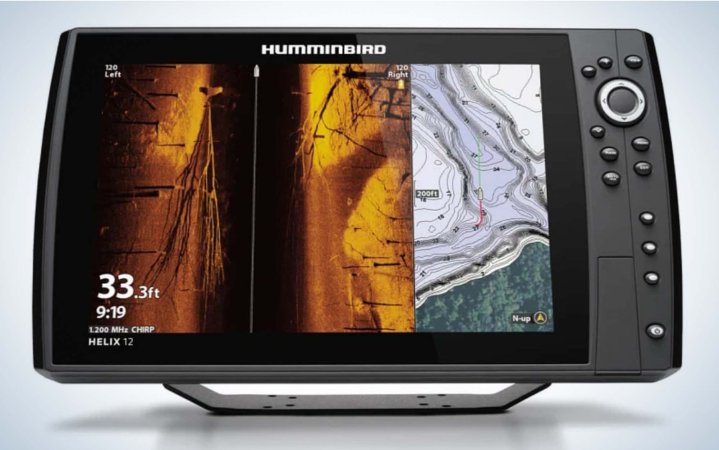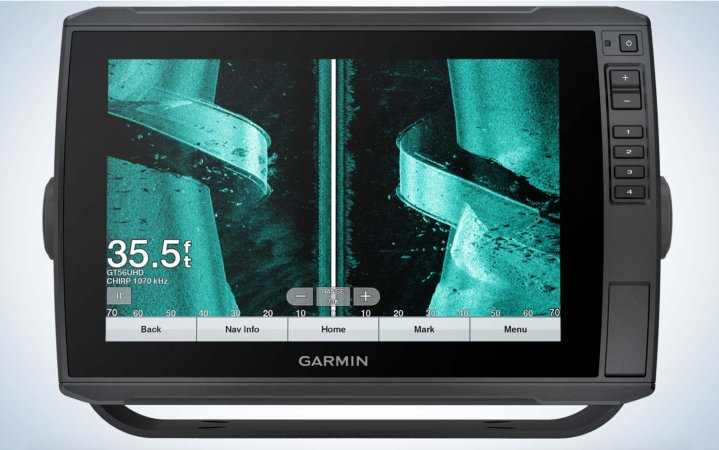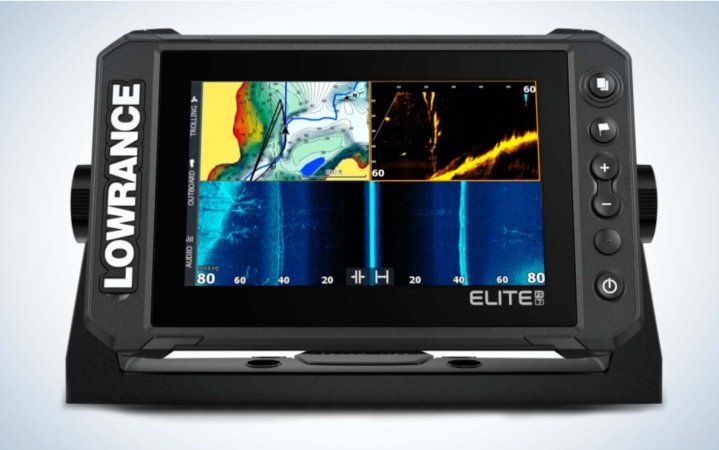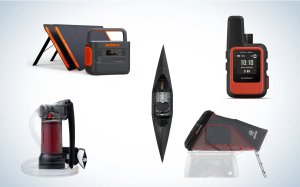We may earn revenue from the products available on this page and participate in affiliate programs. Learn More ›
While forward-facing sonar is the subject of much discord among bass anglers, it only impacts a small percentage of bass chasers with enough money and time to invest in it. The dirty little secret of the bass pros is that while FFS helps them find individual bass, rarely would that final step be possible without side-imaging fish finders.
That’s because side-imaging sonar allows them to quickly break down lakes, taking a moving picture of wide areas. Imagine heading to a new lake where you know that fish are somewhere on a massive flat or miles-long section of river ledges. You could get on your trolling motor and cover short stretches very thoroughly but slowly. Or you could get behind the wheel of your boat, kick out the side imaging to 70 or 100 feet in either direction and find every little rock, log, and irregularity.
Side-imaging’s ability to shrink the playing field is its greatest strength. I’ve had it for a decade or so now across multiple brands, and when I have trouble breaking down a fishery, it’s my electronic decoder ring. I still love FFS, which has helped me catch more fish, but the story here is that side-imaging is a more useful tool.
Below, I’ll list some of the best side imaging fish finders on the market and get insights from three pros on why particular brands are best for them.
- Best for Mapping: Humminbird Helix 12 CHIRP G4N Fish Finder
- Best Picture: Garmin 126SV with GT54 Transducer
- Best Budget: Lowrance Elite FS 9 Fishfinder
Best Side Imaging Fish Finders: Reviews & Recommendations
Best for Mapping: Humminbird Helix 12 CHIRP G4N Fish Finder
Key Features
- 12.1-inch display
- MEGA Side Imaging
- Internal GPS and Humminbird Basemap
- Compatible with MEGA Live
- Creates real-time maps
- One-Boat Network allows easy integration with Minn Kota trolling motors and Cannon downriggers
- Price: $2,700
Pros
- Insane mapping capabilities alone make this a great pick
- Easy to use menus
- Side-imaging out to 200 feet
Cons
- Friendly price, but have to spend substantially more to go up to the 15- or 16-inch Solix or Apex.
Humminbird was the first to bring side-imaging to the tournament world, and they continually push the envelope of the technology, most notably with their MEGA imaging, which is crisp and clear. However, Humminbird’s selection of compatible premium chart options for anglers everywhere makes this unit stand out. In particular, the LakeMaster mapping is exceptional, or you could add a Navionics chip. It makes the process super accurate, and if you want to make your own maps, you can create them with AutoChart Live, which integrates LakeMaster features, map depth contours, bottom hardness, and vegetation as you drive your boat. I had prior generations of this unit on two boats, and was very happy behind the wheel, looking for subtleties.
Pro Analysis
New York pro and electronics wizard Kyle Patrick is completing his first year on the Bassmaster Elite Series and qualified for the 2024 Bassmaster Classic by winning a 2023 Open on Lake of the Ozarks. He said that even the lowest levels of side-imaging Humminbird units are exceptionally high quality, something he couldn’t have imagined a few years ago.
“People get bogged down in settings,” he says. “And of course, the palette you choose and the settings you use will be situational, but you literally can go out, turn this one on, and the MEGA Imaging will help you out a lot.”
He added that a lot of fishing on large impoundments and major river systems is done on large flats, so he’ll side image the whole area and mark it. Then he uses Humminbird’s 360 feature before going to FFS.

Best Picture: Garmin 126SV with GT54 Transducer
Key Features
- 13.4-inch screen
- 1280 x 800 resolution
- Garmin Navionics+ inland and coastal maps
- LiveScope compatible
- Real-time mapping
- Price: $1,500
Pros
- Built-in multi-frequency SideVu
- Holds two microSD cards
- Extremely vivid color palettes
Cons
- May not be quite as good as Garmin’s more expensive 8600 series units
After fishing with a number of different pros who showed me their value, I put two 126SVs on my current boat. While I considered two units up front (one exclusively for LiveScope), my budget really only allowed for two total. These two cover most of my needs, although there are times when I’m side-scanning that I’d like something even bigger for my old eyes. Ultimately, though, the 13.4-inch screen does what I need it to do.
I can divide it into three or four sections, using two for side-imaging and one for mapping, and not feel like I’m shorting myself out of any detail or visibility. The screen is so incredibly crisp and detailed that I frequently find small objects at 60, 80, or even 100 feet out. They jump out through the screen, and it doesn’t take a lot of monkeying with settings to get there. If you do need to mess with the settings, I found the menus simple and self-explanatory. The company’s customer service has been great and I’ve had zero bugs whatsoever.
Pro Analysis
Retired Elite Series pro Chad Morgenthaler competed in seven Bassmaster Classics and one FLW championship, and also won two B.A.S.S. events. Today, he guides extensively on Missouri’s Table Rock Lake, where he is happy to go dirt shallow, but is at his best when he’s giving electronics lessons in his or a client’s boat.
“What I really like about Garmin is that their constant research and innovation in transducers makes the clarity second to none,” he says. “Also, once you learn the various menus and settings, it allows you to access information that other units cannot. You can fine-tune every aspect to your desire and to the conditions, whether that means frequency changes, brightness, sensitivity, contrast, or scroll speeds. It’s very user-friendly and it’s fast.”
He teaches his clients that side-imaging shows features and details that FFS will not. “Lure placement is important, and FFS is good if you know what’s there, but you can’t shortcut the system by ignoring side-imaging as a foundation,” he says.
Read Next: 7 Forward Facing Sonar Tips
Best Budget: Lowrance Elite FS 9 Fishfinder
Key Features
- 9-inch screen
- Touch screen
- Can also be used to control Power Pole anchors and Lowrance Ghost trolling motor
- Live sonar- and Active Imaging-compatible
- Preloaded with C-Map Contour+ charts that have 1-foot contours on 8,900 lakes
- Price: $1,000
Pros
- Remarkable clarity in a smallish screen
- Budget friendly price
- Pre-loaded with C-Map Contour+ mapping
Cons
- Divided screen may be tougher for older eyes to decipher
Anglers just looking to get into the side-imaging game, or who will use the unit exclusively for side-imaging, shouldn’t be bullied into thinking they need a television-sized screen to be effective. This 9-inch dynamo has 800 x 480 resolution, and I’ve found it to be easy to get started on and completely non-buggy. For a non-tech guy like myself, that’s a huge plus, but if you want to do even more with it, this sub-$1,000 fish finder offers a lot more. That includes not just premium SideScan technology, but also DownScan imaging and preloaded maps. I wouldn’t want to divide it into three or four pictures, but if you’re just using it for two views (e.g., side-imaging on each side or side-imaging on one and mapping on the other) this may be the best bargain around.
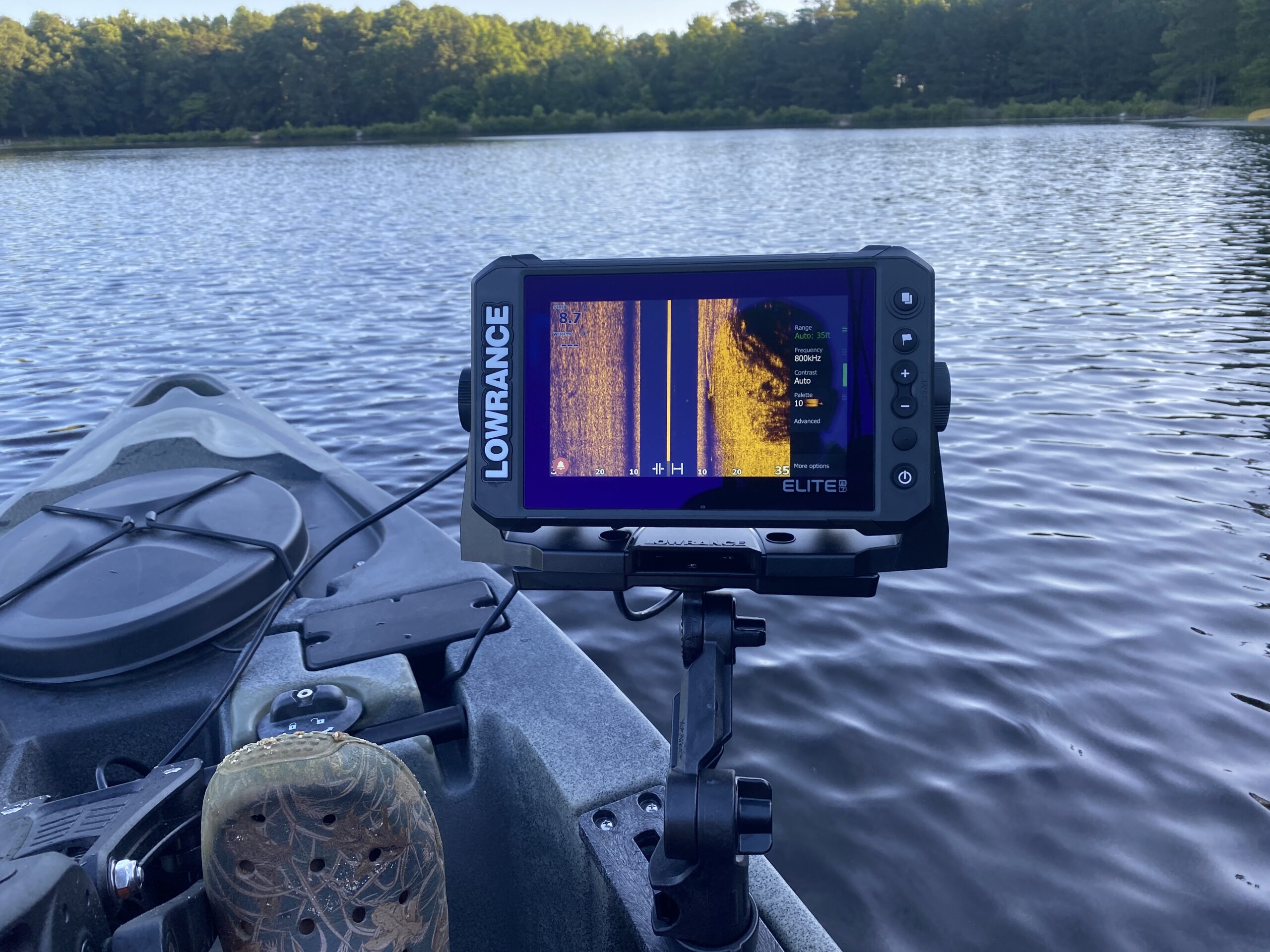
Pro Analysis
Louisiana’s Clark Reehm is a veteran pro who has qualified for two Bassmaster Classics and four FLW championships. He also guides on Sam Rayburn, where he leads “catching” trips as well as dedicated electronics classes. He uses HDS 12 and HDS 16 models, but has been impressed that even the smaller sizes retail the high fidelity of the big ones.
Reehm likes the fact that the Lowrance is effectively “plug and play.” “Many tour level guys run them on straight default out of the box settings,” he says. His usual setup is to run at 100 to 120 feet in either direction, which gives him 200 feet of range, providing enough detail to find brush piles and other high-percentage targets.
“Forward-facing sonar is awesome, but what it doesn’t do is tell you where to stop and start,” Reehm says. “Structure Scan tells me that. In practice and even during a tournament, it is my best tool to deduce really quickly whether there’s bait in the area, a population of fish, or specific targets I need to fish.”
Having compared the Lowrance units to the other brands in some of his competitors’ and clients’ boats, he believes that its processing power shows fish better than the others.
Read Next: Best Fish Finders
How to Choose a Side-Imaging Fish Finder

Budget
The prices of these side-imaging units continues to increase, along with the number of accessories available. By the time you add a mount or mounts, specialized transducers, and map chips, your initial investment has often increased exponentially. Furthermore, most anglers don’t just have one graph on their boat. I’m in the minority of serious bass heads with only two. Even many weekend anglers now have three, four, or even five, and the costs add up quickly. You may also have to add a dedicated battery to power them all day.
Screen Size
Early in my fishing career, I never could have envisioned having a 12-inch screen, but now that I’ve had them at the console on multiple boats, I crave more, especially when side-scanning. I’d like to have that 12-inch screen split scanning to the left and right, and another (probably 7 to 10 inches) used for mapping and/or down-imaging. With the units networked, I could drop a pin on a key spot or see what it looked like in two dimensions without toggling between screens. As with most things in life, if you have the power and the space, get as much screen as you can.
Compatibility
Do you already have a certain brand of graph or a certain type of trolling motor? Keeping things “all in the family” often provides benefits in terms of easy networking and allowing your tools to talk to one another. Some pros like multiple brands because they believe it allows them to see the same image in different ways, but for most of us that’s overkill. In my opinion, a single type of wiring and single brand of gear creates the fewest problems with the most advantages.
Brand
Ultimately, if you’re starting from scratch this is a matter of personal preference. If mapping is paramount, Humminbird seems to be best. I’ve liked the non-bugginess of my Garmins and the fact that their menus are easy to decipher. Meanwhile, Lowrance has a long and storied history in the industry. If your local dealer or rigger prefers one over the other, that may be enough to give you a nudge in that direction.
Final Thoughts on the Best Side Imaging Fish Finders
If you have the patience to use it properly, sitting behind the wheel of your boat and scanning areas thoroughly, side-imaging is the most efficient tool you can possibly use to break down new waters. It takes in wide swaths of the lake’s bottom and shows you what’s there — everything from logs to drop-offs to bottom composition changes to the baitfish and gamefish themselves. I’ve found more sunken items, and hidden gems, by employing it when I have the time. That’s the biggest crux of the matter. It’s not just taking the hours to dial in your unit, and then to learn to interpret it, but also putting down the rod and reel for meaningful periods of time. To be honest, I don’t use it much on local tidal rivers, but when I’m forced to fish lakes offshore, or learn a new body of water, it’s my golden ticket.
- Best for Mapping: Humminbird Helix 12 CHIRP G4N Fish Finder
- Best Picture: Garmin 126SV with GT54 Transducer
- Best Budget: Lowrance Elite FS 9 Fishfinder
